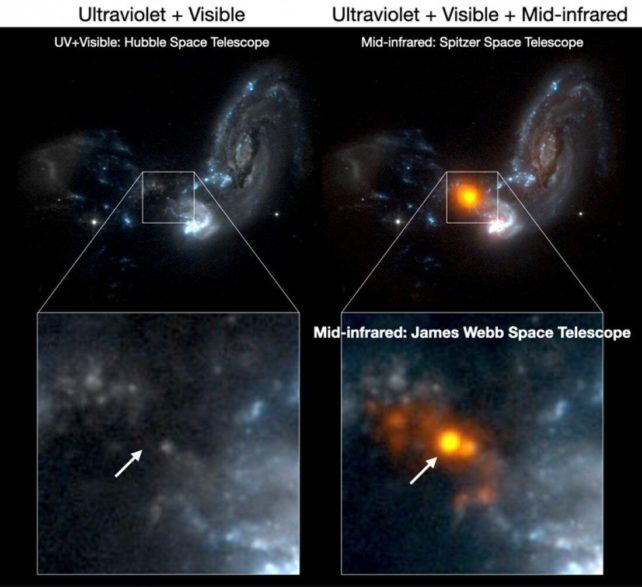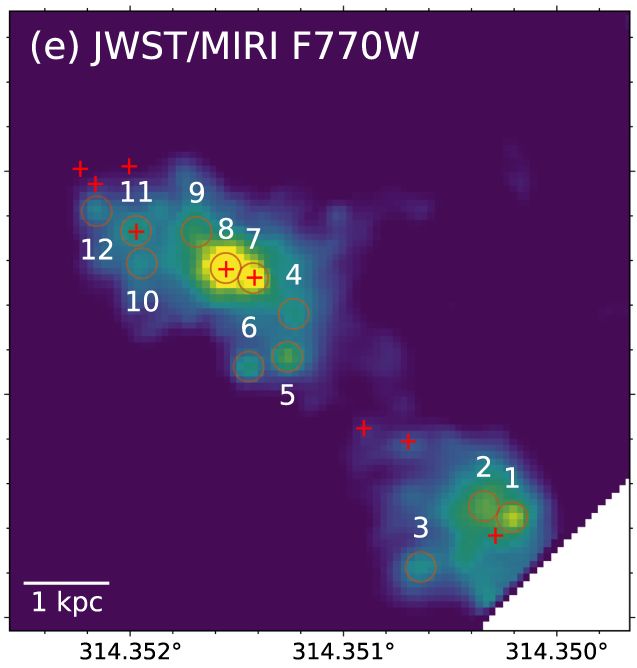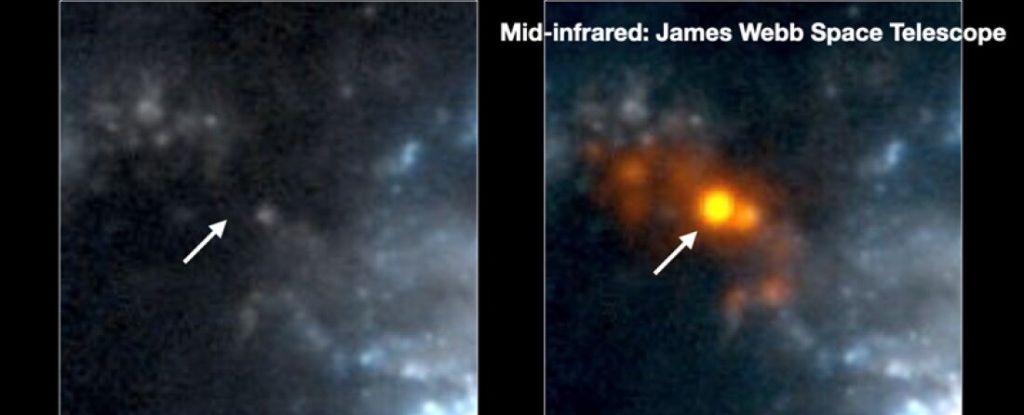Products You May Like
A bright infrared light blazing from two galaxies in the process of merging has just been yanked out of hiding.
Using the JWST, astronomers have pinpointed the exact location of the light, behind a thick wall of dust obscuring it in other wavelengths. Whatever is producing the light is yet unknown, but narrowing down where it is will help figure out what it is, and how it shines so much more brightly than expected.
“The James Webb Space Telescope has brought us completely new views of the Universe thanks to it having the highest ever spatial resolution and sensitivity in the infrared,” says astrophysicist Hanae Inami of Hiroshima University’s Hiroshima Astrophysical Science Center in Japan.
“We wanted to find the ‘engine’ that powers this merging galaxy system. We knew that this source was deeply hidden by cosmic dust, so we could not use visible or ultraviolet light to find it. Only in the mid-infrared, observed with the James Webb Space Telescope, do we now see that this source outshines everything else in these merging galaxies.”
Although the Universe is mostly empty space, mergers between galaxies are not uncommon. Massive galaxies are drawn together by the inexorable pull of gravity, combining to form larger galaxies.
It’s not even some remote thing that only happens to other galaxies elsewhere: the Milky Way itself is a cosmic Frankenstein’s monster, partially made up of all the other galaxies it’s subsumed over its billions of years of life.
Many examples of galactic mergers at various stages have been found out there in the wider Universe, but it’s a slow process that can take millions to billions of years.
Scientists have to take the examples we have and reconstruct the timeline around them, like a single frame from a film, and the only other examples are single frames from similar, but different, films. It’s painstaking work, but it’s one of the best tools we have for understanding galaxy mergers.
We also know, from the light emitted from these mergers, that they’re pretty lively. Although galaxies are mostly space, stars can collide with each other, or gravitationally interact to disrupt each other’s orbits.
The clouds of star-forming gas between the stars can also bump up against each other, generating shocks that can trigger furious waves of star formation known as a starburst, visible as infrared light gleaming out of clouds of dust.
This is what scientists expected to see when they turned the infrared Spitzer Space Telescope to a galaxy merger 500 million light-years away called IIZw096 in 2010.
Instead, they found a bright infrared light shining in the middle of the ongoing collision. Unfortunately, Spitzer wasn’t offering a high-enough resolution to find the exact location of the light source, and the mystery had to be put aside.
That’s because the longer wavelengths of infrared light don’t scatter off dust the way shorter wavelengths do, and Spitzer was top of the line in its time, so no other telescope had a hope of getting closer. Then along came the JWST, and Inami and her colleagues went for a closer look.

They found that the source makes up around 70 percent of the mid-infrared light emitted by the merging galaxies. In addition, although the two galaxies together span about 65,000 light-years, the infrared source has a maximum radius of 570 light-years. This suggests that the source of the emission is very compact.
We know that the material around an active black hole emits a lot of light, and that the supermassive black holes at the centers of galaxies can merge when they meet at the center of the merger. But the location of the light is peculiar; it’s not at the center of either galaxy where you’d normally expect to find such a black hole.
“We want to know what powers this source: is it a starburst or a massive black hole?” Inami says.
“We will use infrared spectra taken with the James Webb Space Telescope to investigate this. It is also unusual that the ‘engine’ lies outside of the main parts of the merging galaxies, so we will explore how this powerful source ended up there.”

The researchers also identified 12 smaller sources of mid-infrared light in the JWST data, clustered around the bright “engine”. Some of those smaller clumps had been seen before in near-infrared data from Hubble, but five of them were new.
They are less mysterious – the light profile fits starburst activity – but they do indicate that something energetic is going on at the point where the two galaxies meet.
Future analysis, the researchers hope, will lead to an identification of the source of the mysteriously bright light. Meanwhile, they are planning more observations to help characterize the dust and gas in and around the ongoing and peculiar collision.
The research has been published in The Astrophysical Journal Letters.
